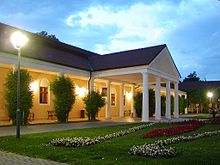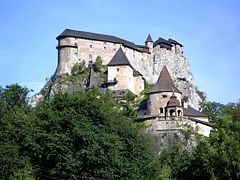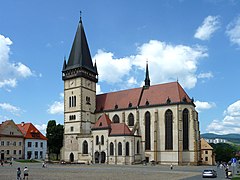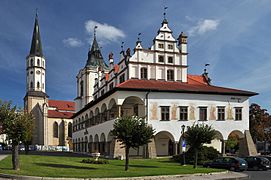
Slovakia, officially the Slovak Republic, is a landlocked country in Central Europe. It is bordered by Poland to the north, Ukraine to the east, Hungary to the south, Austria to the west, and the Czech Republic to the northwest. Slovakia's mostly mountainous territory spans about 49,000 square kilometres (19,000 sq mi), hosting a population exceeding 5.4 million. The capital and largest city is Bratislava, while the second largest city is Košice.

The music of Slovakia has been influenced both by the country's native Slovak peoples and the music of neighbouring regions. Whilst there are traces of pre-historic musical instruments, the country has a rich heritage of folk music and mediaeval liturgical music, and from the 18th century onwards, in particular, musical life was influenced by that of Austria-Hungary. In the 19th century, composers such as Ján Levoslav Bella began to write romantic music with a Slovak character. In the twentieth century, there were a number of composers who identified with Slovak culture. After the fall of communism in 1989–90 the country also began to develop its own popular music scene in Western style.

Banská Štiavnica is a town in central Slovakia, in the middle of an immense caldera created by the collapse of an ancient volcano. For its size, the caldera is known as the Štiavnica Mountains. Banská Štiavnica has a population of more than 10,000. It is a completely preserved medieval town. Because of their historical value, the town and its surroundings were proclaimed by the UNESCO to be a World Heritage Site on December 11, 1993.
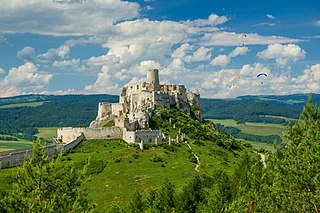
Spiš is a region in north-eastern Slovakia, with a very small area in south-eastern Poland. Spiš is an informal designation of the territory, but it is also the name of one of the 21 official tourism regions of Slovakia. The region is not an administrative division in its own right, but between the late 11th century and 1920 it was an administrative county of the Kingdom of Hungary.

Levoča is a town in the Prešov Region of eastern Slovakia with a population of 14,700. The town has a historic center with a well-preserved town wall, a Gothic church with the highest wooden altar in the world, carved by Master Pavol of Levoča, and many other Renaissance buildings.

The Prešov Region, also Priashiv Region, is one of the eight Slovak administrative regions and consists of 13 districts (okresy) and 666 municipalities, 23 of which have town status. The region was established in 1996 and is the most populous of all the regions in Slovakia. Its administrative center is the city of Prešov.

Bardejov is a town in North-Eastern Slovakia. It is situated in the Šariš region on a floodplain terrace of the Topľa River, in the hills of the Beskyd Mountains. It exhibits numerous cultural monuments in its completely intact medieval town center. The town is one of UNESCO's World Heritage Sites and currently maintains a population of about 32,000 inhabitants.

The Žilina Region is one of the eight Slovak administrative regions and consists of 11 districts (okresy) and 315 municipalities, from which 18 have a town status. The region was established in 1923, however, in its present borders exists from 1996. It is a more industrial region with several large towns. Žilina is the region administrative center and there is a strong cultural environment in Martin.
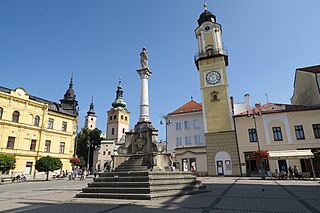
The Banská Bystrica Region is one of the eight regions of Slovakia. It is the largest of the eight regions by area, and has a lower population density than any other region. The Banská Bystrica Region was established in 1923; its borders were last adjusted in 1996. Banská Bystrica consists of 514 municipalities, 24 of which have town status. Its administrative center is the eponymous town of Banská Bystrica, which is also the region's largest town. Other important towns are Zvolen and Lučenec.

Spišská Nová Ves is a town in the Košice Region of Slovakia. The town is located southeast of the High Tatras in the Spiš region, and lies on both banks of the Hornád River. It is the biggest town of the Spišská Nová Ves District.

Stará Ľubovňa is a town with approximately 16,000 inhabitants in northeastern Slovakia. The town consists of the districts Podsadek and Stará Ľubovňa.

Spišská Kapitula is an exceptionally well-preserved ecclesiastical town on the outskirts of Spišské Podhradie, Slovakia, and overlooking Spiš Castle. It is part of the UNESCO World Heritage Site "Levoča, Spiš Castle and the associated cultural monuments".

Stará Lesná or "Old Forest" is a village and municipality in Kežmarok District in the Prešov Region in north-central Slovakia. Stará Lesná is located in an area traditionally known as Spiš and it is situated within the Slovak Tourism Region of the Tatras.

The culture of Slovakia is influenced by its Catholic culture, its various folk traditions, and its location in Central Europe. Slovakian culture shares certain similarities with the cultural traditions of its neighbouring countries: Poland, Ukraine, Hungary, Austria and Czech Republic.

Liptov is a historical and geographical region in central Slovakia with around 140,000 inhabitants. The area is also known by the German name Liptau, the Hungarian Liptó, the Latin name Liptovium and the Polish Liptów.

Beer in Slovakia has been produced and consumed at least since the 15th century. Together with the neighbouring Czech Republic, with whom it has a shared and intertwined history, Slovakia has a number of breweries and a rich beer culture.

The Basilica of St. James is a Gothic church in Levoča, Prešovský kraj, Slovakia. Building began in the 14th century. It is a Catholic parish church, dedicated to James the Apostle.
The architecture of Slovakia has a long, rich and diverse history. Besides Roman ruins, Slovakia hosts several Romanesque and Gothic castles and churches, most notably Spiš Castle, which were built at the time of the Kingdom of Hungary. Renaissance architecture was of particular relevance in town hall squares, such as in Bardejov and Levoča. Affluent architecture in the following centuries made use of Baroque, Rococo and historicist styles, while vernacular architecture in the countryside developed a specific style of wooden houses and wooden churches. In the 20th century, Slovakia knew Art Nouveau and modernist architecture, including socialist modernism, and finally contemporary architecture.

